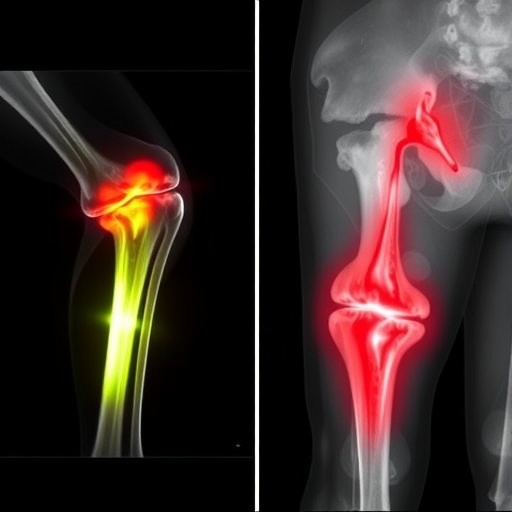In a groundbreaking study published in Advances in Therapy, researchers have delved into an innovative technique aimed at alleviating a commonly misunderstood condition known as meralgia paresthetica. This condition, characterized by tingling, numbness, and burning pain along the outer thigh, is primarily caused by the compression or damage to the lateral femoral cutaneous nerve. Traditional treatments often fall short, leaving patients in search of more effective solutions. The recent findings offer new hope, showcasing lateral femoral cutaneous nerve radiofrequency ablation as a promising option to combat this distressing ailment.
The research team, led by experts Abd-Elsayed, Sahin, and Shiferaw, embarked on a mission to enhance the quality of life for patients suffering from meralgia paresthetica. Their pursuit of a better understanding of the condition highlighted not just the challenges associated with it but also the potential for innovative therapeutic approaches. The promising results of their study could mark a significant advancement in the field of pain management.
Through the use of radiofrequency ablation, the researchers aim to disrupt the pain signals transmitted by the lateral femoral cutaneous nerve, thereby offering relief to those afflicted. This technique involves using heat generated from radio waves to target the nerve tissue, effectively decreasing the nociceptive input that often leads to chronic discomfort. By focusing on this specific nerve, the researchers have discovered a minimally invasive alternative to more traditional surgical interventions.
Beyond the technical aspects of the procedure, the team provided a comprehensive overview of the steps involved in the radiofrequency ablation technique. Candidates for this treatment typically undergo a thorough evaluation, including imaging studies, to confirm the diagnosis and rule out other potential causes of pain. Armed with this information, the medical team can confidently proceed with the ablation process, ensuring a more targeted and effective approach.
During the procedure, a specialized electrode is inserted near the lateral femoral cutaneous nerve. This electrode is then connected to a radiofrequency generator that produces controlled heat. As the heat is applied to the nerve, it alters the function of the nerve fibers, leading to a reduction in pain signaling. This technique has changed the landscape of pain management, allowing patients to experience lasting relief without the need for extensive recovery periods associated with traditional surgical techniques.
The research found that the patients who experienced this novel treatment reported significant improvements in their symptoms, with many stating that the pain that initially disrupted their daily lives had noticeably diminished. What’s particularly impressive is the degree of satisfaction expressed by patients following the procedure, as many reported not only pain relief but also an overall enhancement in their quality of life.
There’s a growing consensus within the medical community regarding the benefits and effectiveness of this technique. As more clinicians become aware of the advantages of radiofrequency ablation for conditions like meralgia paresthetica, it’s likely that this procedure will become a standard practice in pain management. The researchers highlight the importance of educating fellow healthcare professionals about the efficacy of this approach, contributing to a broader adoption in treating patients suffering from similar neuropathic pain conditions.
Looking ahead, the success of this study paves the way for further research and exploration into similar applications of radiofrequency ablation. The authors emphasize the need for larger, multicenter trials to confirm their findings and establish standardized protocols for the procedure. This would address various patient demographics and consider long-term outcomes, ensuring that this treatment remains safe and beneficial for the widest range of patients possible.
Another key aspect of the research focuses on the implications of such a treatment in reducing reliance on opioid analgesics. With the ongoing opioid crisis posing a significant public health challenge, alternative pain management strategies such as radiofrequency ablation support the movement towards safer, non-addictive options for managing chronic pain. The research team underscores the importance of holistic and multidisciplinary approaches in the field of pain management, integrating cutting-edge techniques into clinical practice.
Moreover, researchers encourage patient involvement in treatment decisions, emphasizing the importance of informed consent and shared decision-making. By understanding the benefits and risks associated with radiofrequency ablation, patients can take an active role in their healthcare, fostering a sense of empowerment and control over their treatment pathways. This aligns with the broader movement towards patient-centered care in modern medicine.
In summary, the study led by Abd-Elsayed and colleagues signifies a pivotal moment in the treatment of meralgia paresthetica and potentially other neuropathic pain conditions. The lateral femoral cutaneous nerve radiofrequency ablation technique exemplifies innovation in the realm of pain management, providing an effective solution for those who have long struggled with chronic discomfort. The researchers advocate for ongoing dialogue within the medical community to ensure that these advancements reach those who need them most.
The insights gained from this research not only contribute to the existing body of knowledge but also inspire future investigations into the many facets of nerve pain management. As the healthcare landscape continues to evolve, the integration of effective, minimally invasive techniques like radiofrequency ablation represents a hopeful and transformative shift towards better patient outcomes.
Subject of Research: Lateral Femoral Cutaneous Nerve Radiofrequency Ablation for Meralgia Paresthetica
Article Title: Lateral Femoral Cutaneous Nerve Radiofrequency Ablation for Meralgia Paresthetica: A Description of a Novel Technique.
Article References: Abd-Elsayed, A., Sahin, M.Z. & Shiferaw, B.T. Lateral Femoral Cutaneous Nerve Radiofrequency Ablation for Meralgia Paresthetica: A Description of a Novel Technique. Adv Ther (2025). https://doi.org/10.1007/s12325-025-03360-y
Image Credits: AI Generated
DOI: 10.1007/s12325-025-03360-y
Keywords: Meralgia Paresthetica, Lateral Femoral Cutaneous Nerve, Radiofrequency Ablation, Pain Management, Chronic Pain, Neuropathic Pain.




